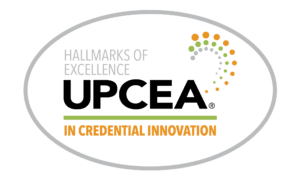UPCEA Credential Maturity Index
UPCEA has identified eight pillars that define what it means to lead credential innovation in higher education, distilled as the UPCEA Hallmarks of Excellence in Credential Innovation. These pillars, or best practices, are a collection of aspirational markers that can help guide institutions as they integrate their universities with the needs of employers and professions with agility, transparency, and accountability. The Hallmarks of Excellence in Credential Innovation are available as a free, downloadable resource, and members of the higher education community are welcomed to use them in any number of ways.
Recognizing that each institution is approaching this work uniquely, and therefore has unique needs and resources, UPCEA has developed a Credential Maturity Index, based on the Hallmarks of Excellence in Credential Innovation. This index will help individuals assess their unit or institutional efforts around alternative credential development for purposes of gauging relative prowess in a particular area, considering growth potential, assessing gaps, and for purposes of continual improvement. The index provides users with an anonymous score for each Hallmark, enabling targeted learning and improvement.
What to do:
Set aside about 15-20 minutes, and have the UPCEA Hallmarks of Excellence in Credential Innovation downloaded and handy as a reference. The Credential Maturity Index is a tool that can help you examine your organization’s relative maturity around eight best practices, or hallmarks, with regard to credential innovation. As such, you are invited to respond to prompts for each hallmark on behalf of your organization.
Each hallmark, for example the first one, “Advocacy and Leadership within the University,” will pose a series of prompts around how your institution has organized efforts around elements related to that particular practice, like engagement, strategy, leadership, etc. You are invited to scan each prompt and gauge your organizational efforts in terms of four markers: Optimized (doing this work consistently), Established (processes are in place, but we have some gaps), Initiated (this work is begun but is not yet formalized or being done consistently), or Not Started.
Index respondents will receive a set of scores for their unit or institution, correlated to their responses to the prompts around each of the eight Hallmarks of Excellence, which they may use to seek further professional development, resources, or networking opportunities. For example, an institution might score highly on Faculty Development but display gaps in Internal Advocacy; the quantification of these strengths and gaps can be used in a variety of ways, leveraging strengths and “mean score” respondents receive will be dependent on the number of other responses received--in other words, it will vary, so we’ll offer some guidance around this from time to time.]
Looking for more details around each hallmark to fuel your unit’s credential innovation journey? Check out each of the Hallmarks of Excellence in Credential Innovation:

1.) Advocacy and Leadership within the University (page 4): Recognizing that alternative credentials, by their very nature, challenge traditional settings, those leading efforts to expand credential offerings need to be adept and agile in defining and defending these in the languages, values, mission, and structures of academe—and potentially within a culture of skepticism.
2.) Entrepreneurial Initiative (page 9): Recognizing that new forms of credentialing command imagination and investigation, risk-taking and respect for academic processes, and a skill set to manage change responsibly, those leading these efforts must have the drive and discipline to create new initiatives.
3.) University to Business Stakeholder Engagement (page 16): Recognizing that new forms of credentialing cannot occur in an ivory tower, those leading these efforts must welcome employers, professions, and industries as partners; respond to their needs and objectives; and seek their ongoing involvement, and even expertise, in ways uncommon in traditional academe.
4.) The Faculty Experience (page 20): Recognizing the role of subject-matter expertise in learning, those leading these efforts must identify and cultivate teaching talent—from within and beyond the academy—and ensure their success in traditional and online classrooms.
5.) The Learner Experience (page 24): Recognizing that the learner might seek a swift, convenient, and even transactional relationship, those leading these efforts must design programs that are easily accessible and immediately valuable.
6.) Digital Technology (page 29): Recognizing the need to bundle a lifetime of unique credentials and accomplishments, those leading these efforts must find new ways of verifying learning and enabling students to document their achievements.
7.) External Advocacy (page 33): Recognizing the ill-defined, unregulated, and poorly understood nature of alternative credentials, those leading these efforts must find external forums to educate consumers and other constituents on the value of alternative credentials by building awareness, appreciation, and, ultimately, consistency.
8.) Professionalism (page 37): Recognizing the general lack of oversight and clarity in this dynamic phase, those leading these efforts have a unique historical opportunity to envision and embody exemplary professional standards of both excellence and integrity.
Be sure to share your results across your teams and campus—or, better yet, take the assessment collectively.
Interested in a more intensive response to your institutional strength and opportunities? UPCEA’s Research and Consulting team can help. Please contact Stacy Chiaramonte ([email protected]) for information on custom research and consulting options.
Questions about the index? Please don’t hesitate to contact Amy Heitzman ([email protected]).
